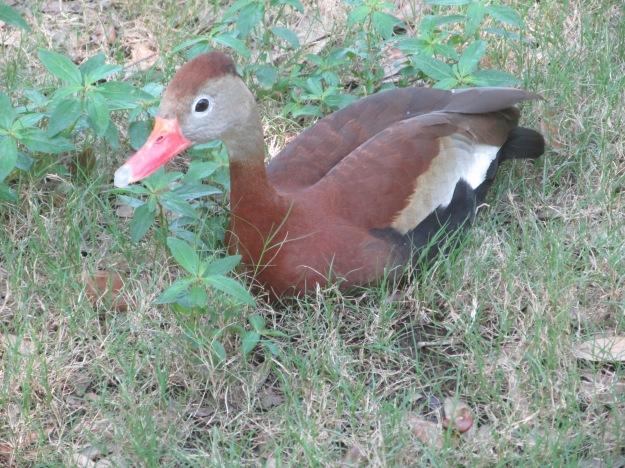
Photo by Bryan Stevens • A black-bellied whistling duck rests inside an aviary located at Brookgreen Gardens in South Carolina. In the wild, this species of duck has been expanding its range in the southern United States.
Joanne Campbell notified me via Facebook of a visit of an unusual waterfowl on Saturday, May 18, at her home near Middlebrook Lake in Bristol, Tennessee.
I needed a moment to look past the obvious Canada goose in the photograph before my eyes registered the four small ducks on the grassy bank. I recognized them instantly as black-bellied whistling ducks.
Black-bellied whistling ducks are members of a group of ducks known as “tree ducks” and “whistling ducks.” There is some debate about whether they are more closely related to ducks or geese.
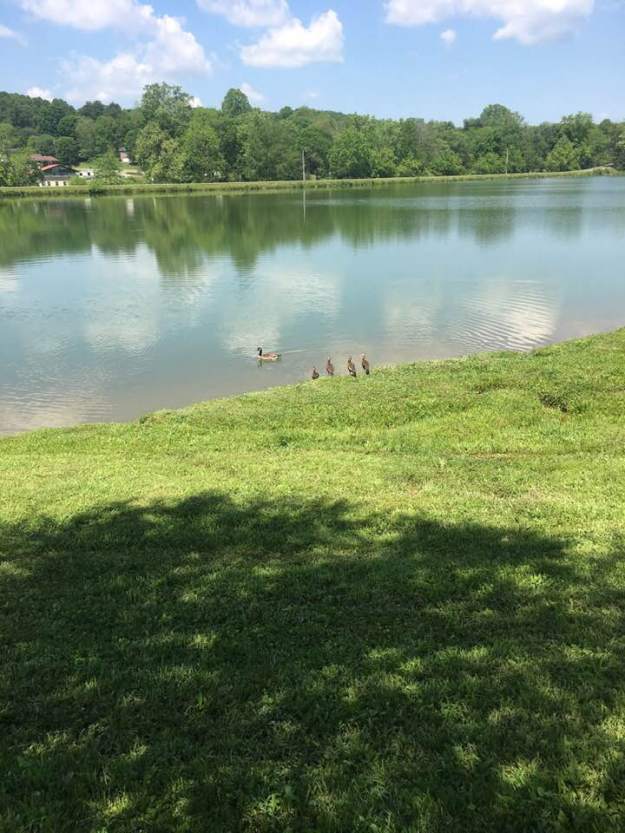
Photo courtesy of Joanne Campbell • The four visiting black-bellied whistling ducks line up along the edge of Middlebrook Lake as a Canada goose swims past.
Joanne’s recent sighting near her home culminates a series of sightings throughout the region over the past month or so. For whatever reason, these ducks have popped up in various locations throughout the region in recent weeks.
Birder and photographer Adam Campbell found 11 black-bellied whistling ducks at a new retention pond off Exit 14 along Interstate 81 in Abington, Virginia, on Sunday, May 12.
A month earlier, birder Graham Gerdeman, a resident of Nashville, Tennessee, found a black-bellied whistling duck at the Harpeth/Morton Mills Greenway in Nashville on Friday, April 12.
On Friday, April 19, another lone black-bellied whistling duck was spotted in a grocery store parking lot in Fairview near Murfreesboro, Tennessee, by birder Kathy Malone.
Birders Ronald Hoff and Dollyann Myers observed a black-bellied whistling duck on Friday, May 17, on a small lake on Highway 411 south of Maryville, Tennessee, on the line between Blount and Loudon counties.
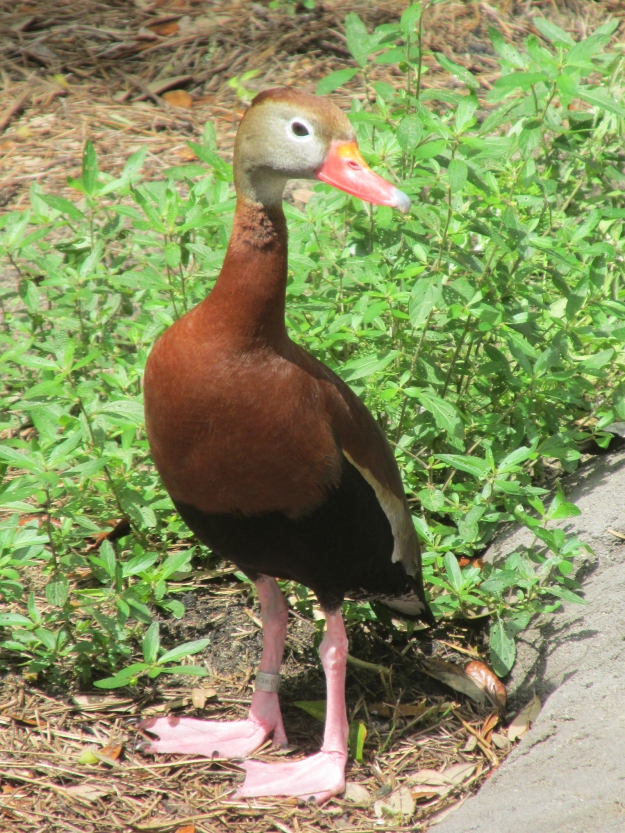
Photo by Bryan Stevens • Although widely kept in aviaries, black-bellied whistling ducks are becoming increasingly frequent wild visitors in the Volunteer State. East Tennessee saw a spike of sightings this spring of this duck.
In West Tennessee, closer to the Mississippi River waterfowl migration flyway, the black-bellied whistling duck is a more common bird. The ducks, which are typically found in Central and South America, range into the United States typically only in southern Texas and Arizona, as well as occasionally in Louisiana, Mississippi, Arkansas and Florida. Some field guides indicate that these ducks are not long-distance migrants, but birders in western Tennessee would disagree with that assessment.
In appearance, males and females are similar with long necks, red bills and long, pinkish-red legs. The plumage is mostly chestnut with a black belly and a readily visible white wing patch.
These ducks are often described as being somewhat similar to geese and are not considered true ducks. They are classified by biologists in the genus Dendrocygna. Species in the genus include the West Indian whistling duck, wandering whistling duck, fulvous whistling duck, plumed whistling duck, spotted whistling duck, lesser whistling duck and white-faced whistling duck. Only the fulvous whistling duck joins the black-bellied whistling duck in ranging into the United States in such locations as Florida, Louisiana, Texas and California.
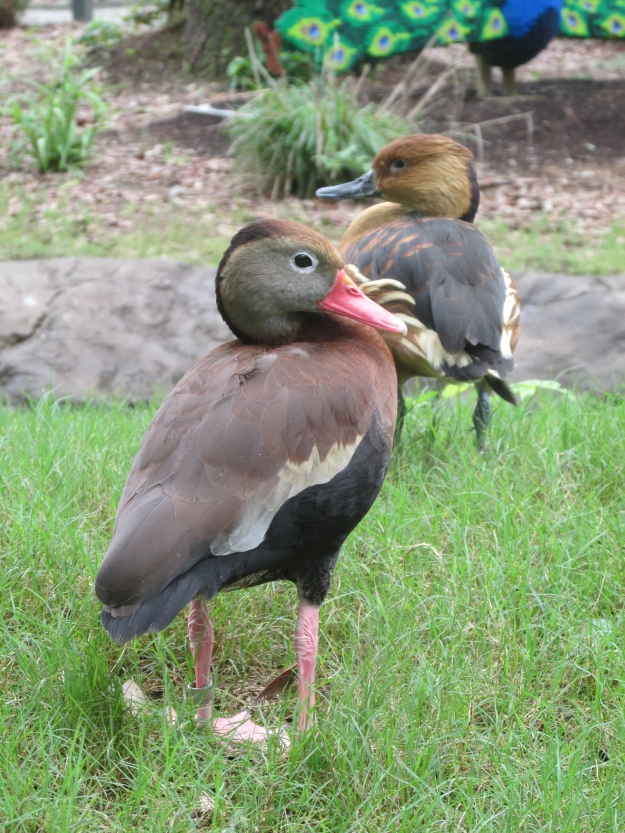
Photo by Bryan Stevens • A black-bellied whistling duck (foreground) and a fulvous whistling duck (background) share space within an aviary at Brookgreen Gardens in South Carolina.
Black-bellied whistling ducks will nest both in natural cavities or on the ground in areas with thick vegetation. If nesting boxes are available, these ducks will gladly nest in them. According to the North American Breeding Bird Survey, black-bellied whistling-ducks have been expanding their range in the southern United States. These ducks have experienced strong population growth, estimated at more than 6 percent per year from 1966 to 2014. The world population is estimated at 1,100,000 to 2,000,000 birds and increasing, which could explain why appearances are becoming somewhat more commonplace in states like Tennessee, as well as Virginia and the Carolinas.
Formerly called the black-bellied tree duck, this waterfowl has also been given common names such as “whistling duck” and “Mexican squealer.” As indicated by these different names, these are highly vocal birds with a clear, piercing whistled call.
The black-bellied whistling ducks at Middlebrook Lake lingered for several hours, which allowed many birders in the region to make the drive to the lake to observe such an interesting visitor to the region.
Joanne later posted on Facebook about the excitement generated by the ducks. “I couldn’t get any work done for watching them,” she wrote in her post.
The ducks are not the first rare bird that Joanne has alerted me to at Middlebrook. Back in November of 2015, she notified me of an American white pelican that spent a couple of days on the lake. I’m grateful to her for notifying me about both the black-bellied whistling ducks and the pelican.
I always enjoy hearing from readers with observations to share. To make a comment, ask a question, or share a sighting, email me at ahoodedwarbler@aol.com.
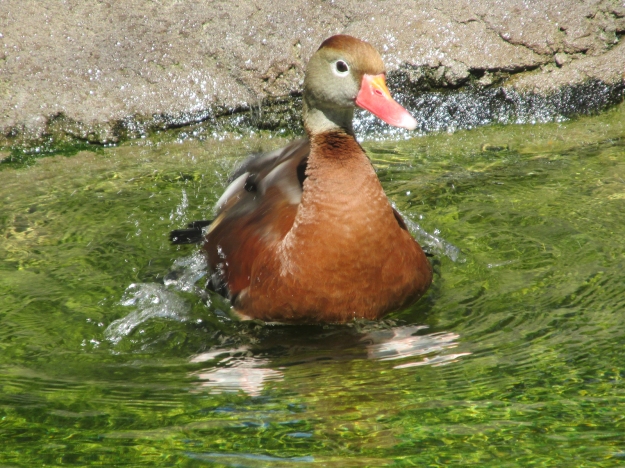
Photo by Bryan Stevens • A black-bellied whistling duck enjoys a vigorous bath within its enclosure in an aviary at Brookgreen Gardens in South Carolina. This duck is often kept in captivity. The wild population has expanded its range in recent years from Central America into the southern United States.
